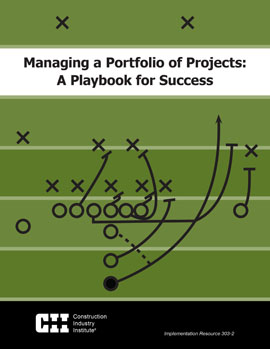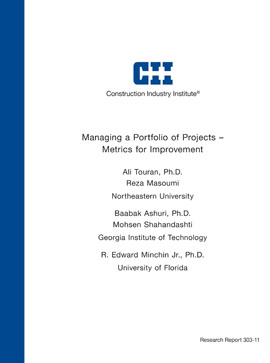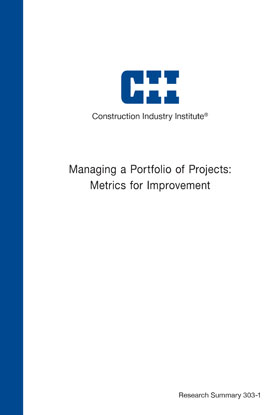
Managing a Portfolio of Projects: A Playbook for Success
Project professionals have a plethora of recommended project management practices available to help them deliver individual projects, but they need to know how to apply these practices when they manage a portfolio of projects. To address this need, CII chartered Research Team 303 to examine the essential question, “What practices, techniques, processes, and technologies are most effective for managing a portfolio of projects?”
After investigating the topic, the research team developed this resource, the portfolio management playbook, as a how-to manual of recommended portfolio management practices. It includes practices for resource management, risk management, financial management, change management, front end planning, and lessons learned—all at the portfolio level. It also recommends a process for portfolio performance management and suggests key performance indicators. To illustrate these practices, it presents an example of a portfolio management system that includes portfolio metrics and dashboards.
Organizations just venturing into portfolio management, as well as those with experience at it, can use this playbook. However, because the research team created it by collecting the practices of many of the most successful and experienced firms, the material may seem familiar and straightforward to organizations with an established portfolio management system. However, these organizations may still find in it new and useful approaches to consider implementing to improve their systems.
Because the playbook presents these proven practices in an accessible format, firms that are new to or just considering implementing portfolio management can confidently use it to set up practices, processes, and metrics for effective portfolio management.
Porfolio Managers should establish and prioritize Key Results Areas (KRAs) for the portfolio with the stakeholders. Typical KRAs include schedule, cost/cash flow, safety and environment, change management/scope, resource allocation, procurement and supply-chain management, quality, risk management, and client satisfaction. (IR303-2, pp. 15-20)
After ranking the KRAs, Portfolio Managers should establish Key Performance Indicators (KPIs) and targets for each KRA to measure portfolio management success. Suggested portfolio level KPIs are identified in the Implementation Resource.
Portfolio managers should utilize front end planning tools to ensure adequate scope definition for projects in the portfolio and to identify and address risks from both a macro and micro standpoint. Portfolio Managers should focus on the following four specific areas to achieve the most effective front end planning across their portfolios: (IR303-2, p. 41)
- Developing an Integrated Process
- Leadership Commitment to a Planning Culture
- Training on Front End Planning Processes
- Ensuring Adequate Scope Definition
With systematic data collection in place, portfolio managers can derive significant value by benchmarking front end planning metrics across their portfolios.
Is a how-to manual of recommended portfolio management practices. It includes practices for resource management, risk management, financial management, change management, front end planning, and lessons learned—all at the portfolio level. It also recommends a process for portfolio performance management and suggests key performance indicators. To illustrate these practices, it presents an example of a portfolio management system that includes portfolio metrics and dashboards.



